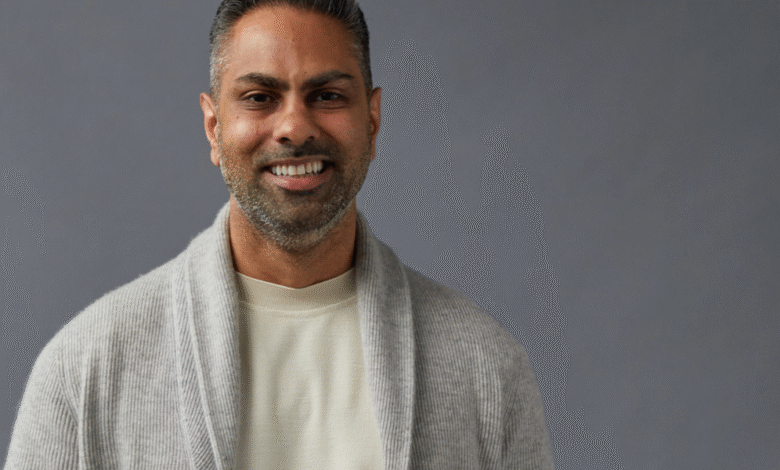Finance guru Ramit Sethi made millions in his 20s—years before Warren Buffett. He says Gen Z can too


- Netflix’s finance guru Ramit Sethi became a self-made millionaire in his twenties—years before Warren Buffett hit that milestone. His advice for Gen Z? Have a vision, take a confident approach toward wealth, and “get the hell out of the spreadsheet.”
Gen Zers are ambitiously aiming to “soft retire” with millions invested at just 45 years old. But they could become self-made millionaires even earlier—while still in their 20s. Netflix’s finance guru Ramit Sethi did exactly that.
To put that into context, Warren Buffett—often hailed as the most successful investor of the 20th century—didn’t notch his first million until age 32. Sethi got there even faster, and now the New York Times best-selling author of I Will Teach You To Be Rich is laying out exactly how Gen Z can follow in his footsteps.
“It’s actually not complicated,” Sethi tells Fortune.
“My entire business, for 21 years, has been showing every day people that you and I can actually get better results than fancy New York City money managers,” he explains.
Sethi’s top tip for getting on the fast track to wealth? Approach your finances with the same self-assurance you feel when you’re nailing it at work or stepping out in your favorite look.
“My advice is, think of another part of life where you are really confident (it could be your fitness or having a great personal style)… Like if you open up your closet, you can see a simple, great outfit. That’s the same way that money works.”
In other words, for Sethi the biggest obstacle people face is thinking that investing is complicated, when in reality the right mindset is to think of it as being as easy as picking out an outfit.
“When money seems so mystical, it seems like these high priests have access to the knowledge, and none of us do, and that is bullshit,” Sethi continues, while adding that in reality the “average investor can actually get better returns than somebody paid a million dollars a year who actually fails to beat the market.”
He’s got a point. Research confirms that “dead” investors—inactive traders who adopt a “buy and hold” investment strategy—often beat the living when it comes to investment returns.
“I don’t log in and check my accounts every day. I don’t sit and check stocks,” Sethi adds.
“What I do is I create a vision, I put my money [aside], I set it up to go automatically where it needs to go, and then I get the hell out of the spreadsheet.”
Even just $50 a month is enough for Gen Zers to kickstart their wealth journey
Of course, some people have a head start over others. Sethi admits his “middle-class” dad helped him set up an investment account when he was just 14 years old.
“I was taking my money from my job and putting it in. It wasn’t a lot, but just having a dad who even encouraged me to do that was incredible and very lucky.”
Ultimately, that early encouragement gave Sethi the confidence that he says is crucial. While you don’t have to be a teenager to start investing, the 42-year-old makes one point clear: the younger, the better.
“When you’re young, you have one luxury that no one else has, and that is the luxury of time,” he adds. “When it comes to investing, time is one of the most powerful allies to live a rich life and grow your investments. So one of the most important things is to be consistently investing even $50 a month, starting from as young as possible.”
Where would he invest that cash?
“One of the simplest investments that I share with my family when they ask is something called a target date fund,” he explains. “A target date fund is such a simple way to get started investing—you literally pick the fund based on the year that you plan to retire.”
For example, for those wanting to retire around the year 2060, Sethi notes there’s a Vanguard Target Retirement 2065 Fund, a Fidelity Freedom 2060 Fund, and a Schwab Target 2060 Index Fund.
“You pick that fund, you automatically set your account up to send money every month, and it invests for you, and that’s it,” he adds. “You certainly do not have to pick stocks. You just set it up once and forget it. It’s literally easier than brushing your teeth.”
Consistency is key here. And whatever you do, don’t try to time the market. Many Gen Zers saw the recent stock market crash as an opportunity to buy in and make thousands.
“Timing the market is for suckers,” Sethi insists. “The best thing you can do is treat your investments like a Thanksgiving dinner. Put the turkey in the oven, close it and let it cook for the next 30 years.”
“For the Gen Z people who feel so proud, ‘I bought the dip bro,’ you might want to consider actually bolstering up your emergency fund,” he adds. “Putting $3,000 in an investment—while great and that will compound over the next 30 years—that money might be a little bit more valuable right now sitting in a high-yield savings account, just in case you get laid off five months from now.”
“So I want people to really get aggressive about building up a 12-month emergency fund.”
TLDR: Too long didn’t read
- Open a target-date fund through providers like Vanguard, Fidelity, or Schwab. Choose a fund matching your expected retirement year (e.g., 2060 fund).
- Set up automatic monthly contributions, even if it’s just $50. The key is starting early and being consistent rather than trying to time the market.
- Focus on low-cost index funds that automatically diversify your investments.
- Don’t overthink it—the most important thing is to start. As Ramit Sethi says, “set it up once and forget it.”
- Simultaneously build a 12-month emergency fund. Consider temporarily reducing 401(k) contributions and pausing extra debt payments on low-interest loans, to funnel that money into a savings account, “and really get aggressive for what may come.”
This story was originally featured on Fortune.com
https://fortune.com/img-assets/wp-content/uploads/2025/04/ramit_sethi_53dee7.png?resize=1200,600
2025-04-25 10:19:31





